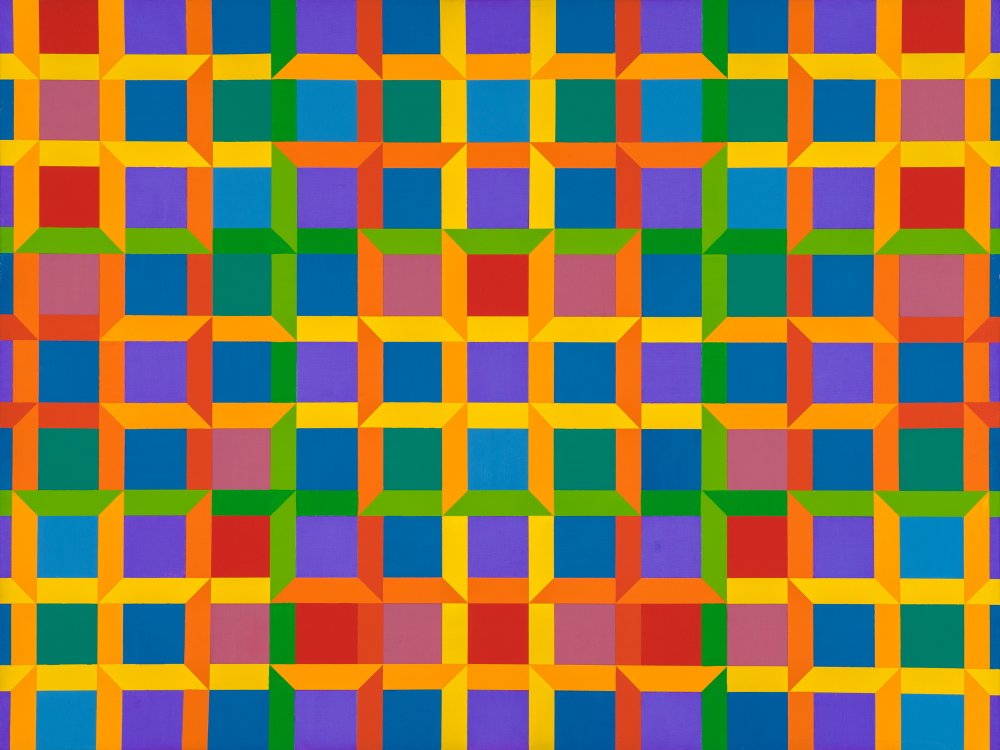Hard Edge Painting

Most of my earlier paintings are done in an abstract geometric hard-edge style, where each region within a painting is created with a single color, the colors are separated with sharp boundaries, and the overall layout is planned in advance. This steers the viewer’s attention towards the interplay of shapes and the juxtaposition of uniform color fields. In some pieces, I choose shapes that create optical illusions (Anxiety), or impossible 3-dimensional objects (Open Hexagonal Lattice I, Open Hexagonal Lattice II, and Closed Quadrilateral Lattice). In other works (Rocket), the relationships between connected shapes in the figure are obfuscated by painting them with contrasting colors.
Hard edges can be achieved with masking tape or with careful hand painting - I use a combination of both methods, depending on the shapes involved. Brush strokes are intentionally minimized, but they are visible upon close inspection, so you can still tell it was made by human hands.
This type of painting appeals to me because it can be simultaneously ancient and futuristic. Early humans have been reproducing geometric patterns for a very long time (500,000 years, by some estimates). Paints were developed more recently, but there is a rich history of geometric designs being created with colorful ceramic tiles, going back thousands of years. On the futurist side, I seek to create combinations of colors and shapes that would be "timeless" enough to be welcome as background artwork on a TV show or movie that is set several hundred (or thousand?) years in the future.
I was inspired to paint in this style when I took classes from Karl Benjamin, one of the pioneers in this movement. (Gateway is the second piece I painted under his instruction.) He was a painting instructor at Pomona College while I was attending Harvey Mudd. I majored in General Engineering, and minored in Art, taking several classes at the other Claremont Colleges.
Hard-edge painting became popular in California in the 1950s and 60s, as a contrast to the free-flowing style of abstract expressionism. As you might notice in my portfolio, I’ve also painted spontaneous pieces that are distinctly outside of the hard edge “rules,"where the paint flies, and you get what you get.
Sometimes I interpret my hard-edge paintings as being symbolic of the times that I "lived in a box”, as a student with a demanding schedule, or as a full-time aerospace engineer that went to work in a cubicle or office every day. Back then, spending my free time working on a canvas with tedious masking and painting steps seemed like a joyful escape. After I started creating custom lighted clothing, I graduated to another level of tedious construction - verifying soldered connections to LEDs and control circuitry, and producing high-quality stitching for all sewn elements. At that point, painting was more fun if it was totally spontaneous and unplanned, so I shifted towards abstract expressionism (the antithesis of hard-edge painting! - see Earth, Rainbow Swirl, Chocolate Swirl). Painting also seemed like a nice way to relax because there was nothing to plug in or turn on at the end. It was just done when the paint dried.
Today, I can’t say that I’m strictly team “pre-planned” or team “spontaneous,” in terms of art creation strategies. I enjoy both, and it’s exciting to see how this dichotomy continues with changes in technology. Lately, with my illuminated art, the tedious pre-planned phase mostly happens during hardware development, and the beautiful spontaneous accidents are allowed to happen later, in software, as I create the animation patterns.







